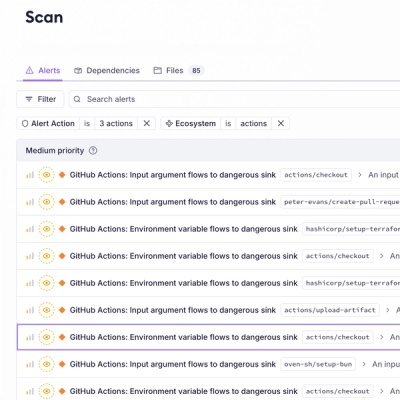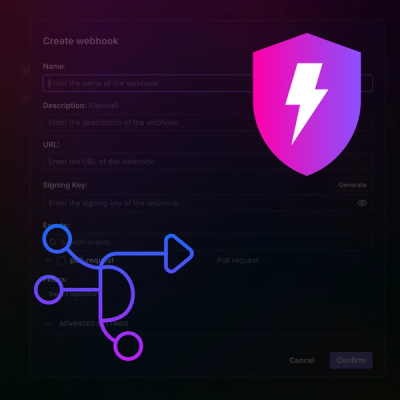
Product
Introducing GitHub Actions Scanning Support
Detect malware, unsafe data flows, and license issues in GitHub Actions with Socket’s new workflow scanning support.
gatsby-source-mailchimp
Advanced tools
Use your Mailchimp API key to download your campaigns into Gatsby's GraphQL data layer!
⚠ Please note: This plugin was made out of a specific necessity, so it doesn't cover all of Mailchimp's data sources, focusing only on campaigns. If you want to add extra functionalities, feel free to create a PR and contribute :smile:
yarn add gatsby-source-mailchimp
# or
npm i gatsby-source-mailchimp --save
// in your gatsby-config.js
module.exports = {
// ...
plugins: [
{
resolve: 'gatsby-source-mailchimp',
options: {
// Avoid including your key directly in your file.
// Instead, opt for adding them to .env files for extra
// security ;)
key: 'asd712jdas90122jdas90122jkadsd1-usXX',
rootURL: 'https://usXX.api.mailchimp.com/3.0',
},
},
],
// ...
};
Go through http://localhost:8000/___graphql after running gatsby develop to understand the created data and create a new query and checking available collections and fields by typing CTRL + SPACE.
| Options | Type | Default | Description |
|---|---|---|---|
| key | string | [required] Your API key | |
| rootURL | string | [required] Your key's root API URL. Usually in the format https://usXX.api.mailchimp.com/3.0 | |
| authUsername | string | GatsbyChimp | In case you want to name your requests, fill this value. |
| campaignFields | array of strings | See the section below | Which fields to fetch from campaigns' metadata. See Mailchimp's documentation on campaigns fields |
| contentFields | array of strings | ['html'] | Which fields to fetch from campaigns' content. See Mailchimp's documentation on campaign content fields |
| nodeType | string | MailchimpCampaign | How to name campaign nodes in GraphQL |
| count | string | 30 | Number of campaigns to fetch. Use 0 in order to fetch them all |
campaignFields valueIn terms of metadata, I believe most users will only need the campaign's type and status for filtering; title for internal usage; send_time for displaying dates for users; and subject_line and preview_text for showing a preview of the campaign. For such, the default fields are as follow:
const defaultCampaignsFields = [
'campaigns.type',
'campaigns.status',
'campaigns.send_time',
'campaigns.settings.subject_line',
'campaigns.settings.preview_text',
'campaigns.settings.title',
];
You can refer to Mailchimp's documentation on campaigns in order to explore what other fields you can fetch, but be aware that you'll have to include these in your custom campaignFields if you want them to show up in results!
If you don't want to attach your API key to the repo, you can easily store it in .env files by doing the following:
// In your .env file
MAILCHIMP_KEY = 'asd712jdas90122jdas90122jkadsd1-usXX';
// In your gatsby-config.js file
require('dotenv').config({
path: `.env.${process.env.NODE_ENV}`,
});
module.exports = {
// ...
plugins: [
{
resolve: 'gatsby-source-mailchimp',
options: {
key: process.env.MAILCHIMP_KEY,
rootURL: 'https://usXX.api.mailchimp.com/3.0',
// ...
},
},
],
// ...
};
This example is based off Gatsby Docs' implementation.
As of now, the only known caveat is that, in order to preserve cache and avoid fetching the HTML content for each campaign every single time (which takes from 20s to 1m for 50 large campaigns), the plugin uses Gatsby's cache in a way that considers changes made only to the campaignFields. If you make a minor change to your HTML, as it stands, you'll have to change some of the campaign metadata that you're pulling into your site.
Unfortunately, Mailchimp doesn't offer a last_edited field, so all we can do for now is to avoid caching alltogether. I haven't added a flag for this because it seems quite unnecessary, but feel free to create an optional avoidCaching param if you need!
The process to save campaigns in gatsby-node.js is as follows:
/campaigns/ endpoint with due limits and pagination (set by user configuration);Promise.all with this array and iterate over it to get each campaign's content;I'm not very literate on licensing, so I just went with MIT, if you have any considerations just let me know! Oh, and, of course, feel free to contribute to this plugin, even bug reports are welcome!
FAQs
Source plugin to fetch campaigns from Mailchimp into Gatsby
We found that gatsby-source-mailchimp demonstrated a not healthy version release cadence and project activity because the last version was released a year ago. It has 1 open source maintainer collaborating on the project.
Did you know?

Socket for GitHub automatically highlights issues in each pull request and monitors the health of all your open source dependencies. Discover the contents of your packages and block harmful activity before you install or update your dependencies.

Product
Detect malware, unsafe data flows, and license issues in GitHub Actions with Socket’s new workflow scanning support.

Product
Add real-time Socket webhook events to your workflows to automatically receive pull request scan results and security alerts in real time.

Research
The Socket Threat Research Team uncovered malicious NuGet packages typosquatting the popular Nethereum project to steal wallet keys.